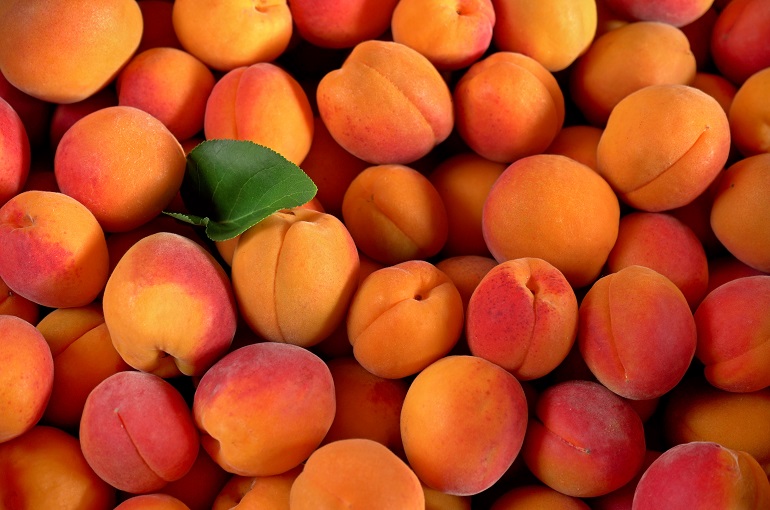Nutrition Value, Health Benefits, Uses, and Interesting facts about Apricot

This post is also available in:
This post is also available in:
![]() Español (Spanish)
Español (Spanish) ![]() Français (French)
Français (French) ![]() Deutsch (German)
Deutsch (German) ![]() हिन्दी (Hindi)
हिन्दी (Hindi) ![]() العربية (Arabic)
العربية (Arabic) ![]() Ελληνικά (Greek)
Ελληνικά (Greek) ![]() Português (Portuguese (Brazil))
Português (Portuguese (Brazil))
Apricot Tree Fast Facts
- Apricot trees are deciduous (they lose their leaves during the winter)
- The tree produces stone, edible and versatile fruits.
- It belongs to the Rosaceae family.
- It belongs to the genus Prunus, and the commercial varieties are classified in the Prunus armeniaca species.
- The Apricot is the national fruit of Armenia.
- Apricots originate from regions of Russia and China.
- They are commonly grown in USDA hardiness/planting zones 5-8.
- Turkey is the greatest Apricot producer (21% of global production).
- Apricot growers use grafted on peach, plum, and apricot rootstocks/seedlings. There are also some Plum-Apricot Hybrids available.
- The tree starts to produce fruits in the 2nd-3rd year of its life.
- The flowers emerge before the foliage of the tree in early spring.
- There are some self-pollinated (self-fruitful) apricot varieties, but the yield is higher when cross-pollination between 2 compatible cultivars occurs.
- Usually, fruit thinning is necessary. This means that the grower has to remove early some underdeveloped fruits, so that the tree will use its resources to produce fewer fruits but of better quality and size.
- On average and depending on the variety and rootstock, apricots are ready to be harvested 100-120 days after flowering.
- Apricots have high nutritional value since they are a source of various vitamins (like vitamin A, B, and C) and antioxidants.
- The Apricot has a unique taste that is difficult to match with any other fruit.
- Apricot pits contain a substance called amygdalin, which is converted to the poison cyanide and is not safe to consume.
History, Production, and Uses of Apricots
Apricots originate from regions of Russia and China. Their cultivation and consumption spread in Europe after 3000 B.C., while they were imported to the United States in the 17th century. Nowadays, apricots are mainly grown in the western Balkans, the Mediterranean Basin, Iran, China, Japan, South Africa, and the USA.
The sweet Apricot can be eaten plain (fresh consumptions as whole fruits or for juice production) or be used as an ingredient in desserts, liqueurs, and confectionery.
We classify cultivated Apricots depending on their use. Thus we have:
- Table/Fresh Apricots
- Industrial Apricots (usually up to 80% of the total production)
Nutritional value and Health Benefits of Apricots
It is widely known that consuming fruits and vegetables is the key to a healthy life. Scientists keep saying how important it is to enter five portions of fruits and vegetables as part of an overall healthy diet to be able to fight most modern lifestyle-related diseases.
According to USDA 100 g of raw Apricots contain:
- Water: 86.35g
- Energy: 48kcal
- Protein: 1.4g
- Total lipid(fat): 0.39g
- Carbohydrate (by difference): 11.12g
- Fiber (total): 2g
- Sugars: 9.24g
- Ca: 13mg
- Fe: 0.39mg
- Mg: 10mg
- P: 23mg
- K: 259mg
- Na: 1mg
- Zn: 0.2mg
- Vitamin A RAE: 96μg
- Vitamin C: 10mg
- Vitamin E: 0.89mg
- Vitamin K: 3.3μg
Apart from the nutritional value of apricots, their consumption as fruit has many significant health benefits:
Boost Heart Health
Apricots are rich in potassium. According to studies, people who follow a diet rich in potassium and poor in sodium tend to have balanced blood pressure levels. Furthermore, according to another study, people who consume 4069mg of potassium daily have almost 50% fewer opportunities to die from ischemic heart disease. In addition, Apricot is rich in powerful antioxidants called flavonoids which protect cells from free radicals that cause oxidative stress.
Boost Skin Health
It is no surprise that most cosmetic skin products have the main ingredient, vitamin C. In fact, vitamin C, which we find in sufficient amounts in Apricots, greatly affects the skin since it participates in collagen formation. Beta carotene, also contained in apricots, is known for its protection against sunburns; thus, it is one of the main ingredients in sunscreens. Either consumed orally or applied topically may reduce wrinkles and damage from pollution and U.V. radiation and improve overall skin health.
May Boost Eye Health
Vitamins A and E, contained in Apricots, are essential for maintaining good eye health. More specifically, vitamin E protects eyes from free radicals that damage cells, while vitamin A protects against a disorder called night blindness.
May boost Gut Health.
Apricots are an excellent source of fiber, which is known to improve gut health by promoting regularity and feeding beneficial gut bacteria.
References
- https://www.ncbi.nlm.nih.gov/pmc/articles/PMC6342773/#CR9
- http://www.fao.org/faostat/en/#data/QC/visualize
- https://ndb.nal.usda.gov/ndb/search/list?qlookup=09032&format=Ful
Apricot Tree Information and Varieties
Nutrition Value, Health Benefits, Uses, and Interesting facts about Apricot
Growing Apricot Trees for Profit
Apricot Soil Requirements, Soil preparation, and Planting
How to Propagate and Pollinate Apricot Trees
How to Train and Prune Apricot Trees
Apricot Trees Irrigation – How to water Apricot trees
Apricot Tree Fertilizer Requirements








































































